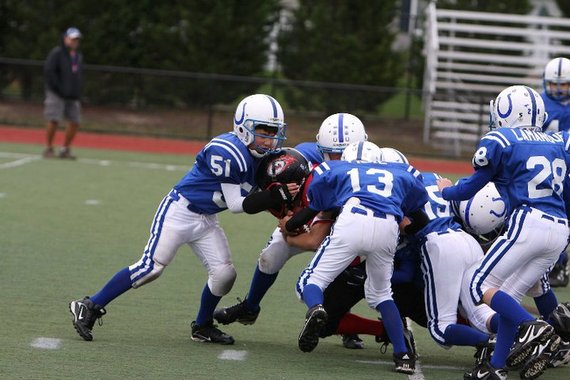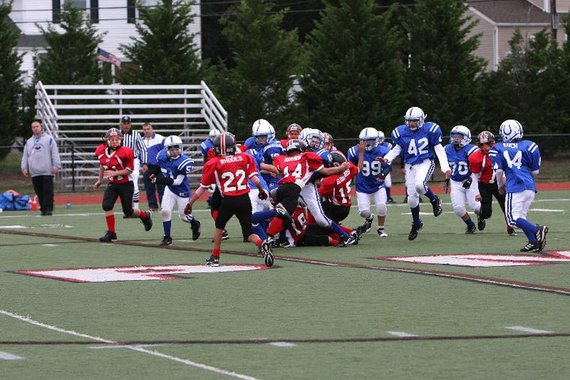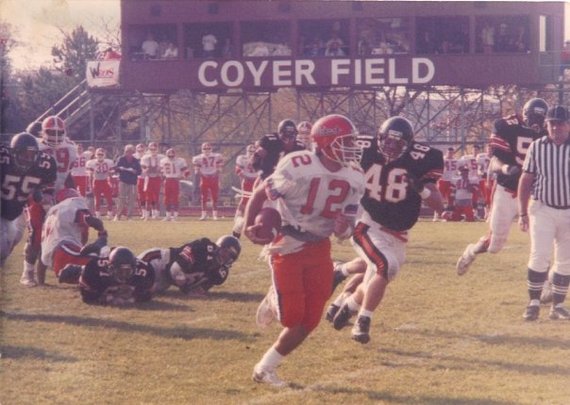
What follows is a true American football moment. It happened on Long Island.
"Break his leg! Break his f---ing leg!"
It was the waning moments of a damp September fourth quarter, and football, as it often does, had brought out the ugly side of one of its fans. In this case, the red-faced rooter was a 30-something dad imploring his son, an outside linebacker, to maim the opposition's running back.
The boys playing were nine and 10. Fifth grade. Pee wees.
The father wasn't a coach. Nor was he one of the three volunteers holding the yard markers. But there he was, stomping along the sideline, ensuring junior could hear dad's commands.
I can only surmise that this man's sideline presence and profanity were permitted because his place of business hosted end-of-season award parties for teams in the local pee-wee league. Perhaps, his bulging biceps and the veins popping from his neck also played a role.
Similarly boorish was the head coach of the team this father was pulling for. His own son had an intense fear of football's most basic requirement - hitting. To remedy this lack of meanness, the coach took several drastic measures.
Two were especially disturbing.
During practice, he routinely would sic the two most aggressive players on the team against his son during full-contact drills. "Again," he shouted, each time his son wound up on the wrong end of a ferocious pummeling. Yes, some 10-year-old's hits are ferocious.
"Don't help him up," the coach would add. Only after the tears flowed from his son's eyes did this moronic exercise cease.
As if this wasn't enough to encourage his son to hate him (and football), the coach had the same two boys come to his home to engage in hitting drills with his son in the backyard. This time - the coach bragged to me - the drills continued in spite of his son's crying.
The coach wasn't much nicer to the rest of his players. Random and nonsensical screaming were the norm during practices. And his sideline griping at games was legendary in its filth, particularly those times when his team fell a "c--- hair" short of reaching a first-down.
Taught and played correctly, football is an incredibly violent game, where the threat of serious injury hovers over every single play. Even the kookiest football parents - the ones that spew blood-curdling screams and howl like wolves when their sons do them proud with big hits and long runs - fear the worst during games and are thankful after every play that their son doesn't need to be carried off the field.
So when you add irresponsible parents masquerading as coaches to the sport, the results are frightening.
From youth leagues to the National Football League, inspiring, compassionate and sensible coaches are abundant at every level of the grid-iron food chain. But so are the ignorant, selfish and immoral ones.
Coach Brady Hoke at the University of Michigan has been widely criticized for allowing his wobbly sophomore quarterback Shane Morris to remain in the Wolverines' home game Saturday, Sept. 27, against Minnesota after a crushing hit that left him stumbling, dazed and obviously concussed.
Students and other fans are calling for Hoke's job. Though, sadly, they really want Hoke axed more because his team is lousy than because of the way he handled his quarterback. Still, a team as big as Michigan's has dozens of coaches and trainers. Someone should have acted fiercely enough to keep the injured Morris off the field.
When the news flashed on my phone Wednesday night that 16-year-old Tom Cutinella died after a violent collision playing football for Shoreham-Wading River High School in Long Island, New York, I was horrified. My thoughts quickly raced to my teenage son, sleeping in the bedroom down the hall. He wasn't yet five and barely 40 pounds when he started playing tackle football.
Outwardly, he enjoyed the game, getting high praise for wild touchdown runs and earning monikers like "assassin" and "terminator" for big hits. But after 10 seasons in helmet and pads, this summer he asserted he would not be playing this fall.
I was quite concerned with what he'd do with his time after school, but my gut reaction was relief - intense relief. Join the golf team, I suggested.
I helped coach my son's youth league teams and I shake my head at some of the tackling and blocking drills I ran my players through. Looking to instill a toughness in little kids who wanted no part of colliding full speed with another child, I reasoned that I was protecting them - that they would be more likely to get injured if they played with fear.
I should have suggested their parents pull them from football and ask for their money back from the league.
Many people are reasoning that deaths like Tom Cutinella's are random. But can it really be a surprise that now and then a child is killed playing a sport where players are dressed like modern day gladiators and success is predicated on which team hits harder? Also, consider that NFL teams erect statues of legends who were essentially paid concussionists, i.e. the Baltimore Ravens' Ray Lewis.
There's a magic in playing football. The game offers discipline and serves up powerful lessons in perseverance. And then there's the camaraderie that you cherish for a lifetime. There's a one-of-a-kind adrenaline rush that comes from battling with all you have alongside your teammates.
Whether we won or lost, I wouldn't trade my football teammates from high school or college for anyone else.
As a player and as a coach, I was under football's spell for a long time. But the mounting data documenting the sport's adverse health effects, along with the NFL's handling of domestic abuse cases and the fact that college athletes still get no share of college sports' $11 billion in annual revenue has broken the enchantment.
Clearly, with hundreds and hundreds of billions tied up in television contracts for college and pro football and with millions of fans attending games at all levels each week, football doesn't need me.
But for the sake of its players, young and old, it needs some change. Here are some suggestions:
- Mandatory training for youth football coaches.
theharmonizer@gmail.com


